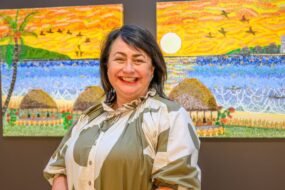
One of the more striking stories to come out of the art world lately is that of Bettina Grossman, an avant-garde artist whose vast archive of photographs, sculptures, film, and paintings is only just coming to light. Bettina (she preferred the mononym) lived in the Chelsea Hotel from 1972 until her death, in her 90s, in 2021. Her estate is now stewarded by the artist Yto Barrada, who recognized Bettina’s creations as not only worth saving but deserving of a wider audience. Cue “Original Order Order Original: The Art and Archives of Bettina,” the largest presentation of the artist’s work to date, now open at Ruth Arts in Milwaukee (through April). The project is both an exhibition and an ongoing excavation: “Just weeks ago we were opening a box of work that no one has ever known existed,” says Rivers Institute for Contemporary Art & Thought director Andrea Andersson, who curated the show. And the art is captivating: undulated carved wood sculptures, candid street photography, experimental 16-mm film. “We’re just catching up to her extraordinary genius.”
Moving further west, the ever-excellent abstract artist Jacqueline Humphries takes over two floors of the Aspen Art Museum starting in December (through April). Humphries, 65, blends traditional painting techniques with signifiers of our modern era—coding language, screen-like silver paint—to offer a 21st-century take on Abstract Expressionism. On her nine-foot-tall canvases, you might find an image not unlike a captcha test. For this exhibition of mostly new work, the New York–based artist returns to fluorescent paints, which under a black light reveal hidden forms. The show makes the case for Humphries as one of our most inventive, ambitious painters.
More than 100 stunning photographs, many of them taken in Central and West African cities in the mid 20th century, make up “Ideas of Africa: Portraiture and Political Imagination” at New York’s Museum of Modern Art (December through July). With the continent’s decolonization movement as a backdrop, image makers like Seydou Keïta, Sanlé Sory, and Malick Sidibé documented the revolutionary energy and Pan-African solidarity in their communities. But rather than a specific slice of history, “Ideas of Africa” shows how the spirit of that time has ricocheted across geographies and generations. As curator Oluremi C. Onabanjo, who organized the show with Chiara Mannarino, explains, the exhibition “takes imagination and movement as its beating pulse.” The photographs here leap off the walls—powerful, stylish, and very much alive.









